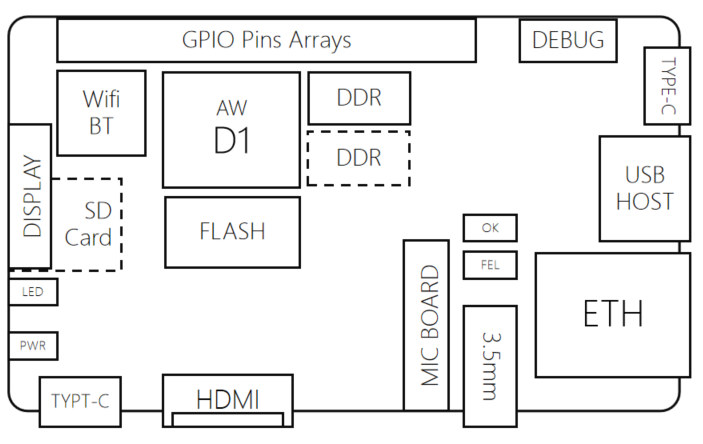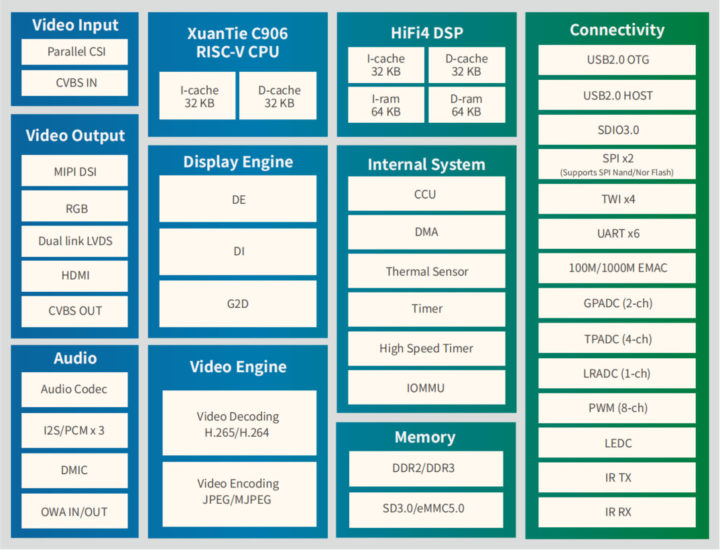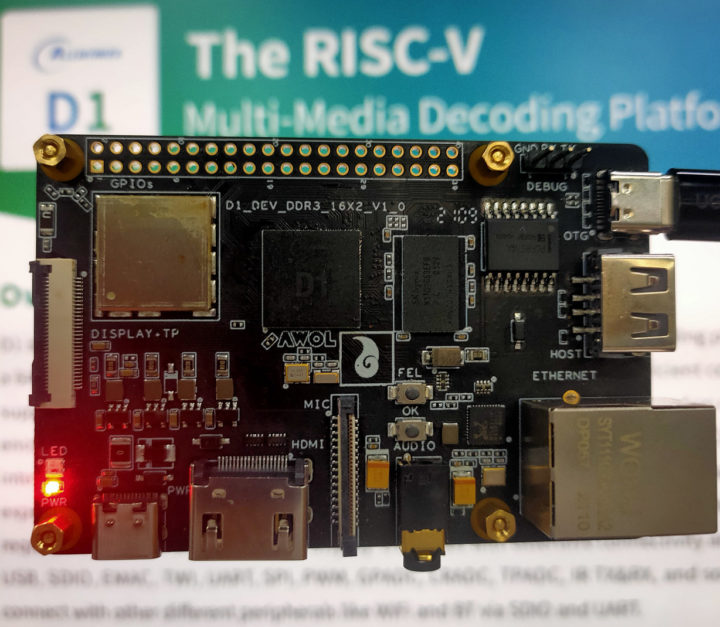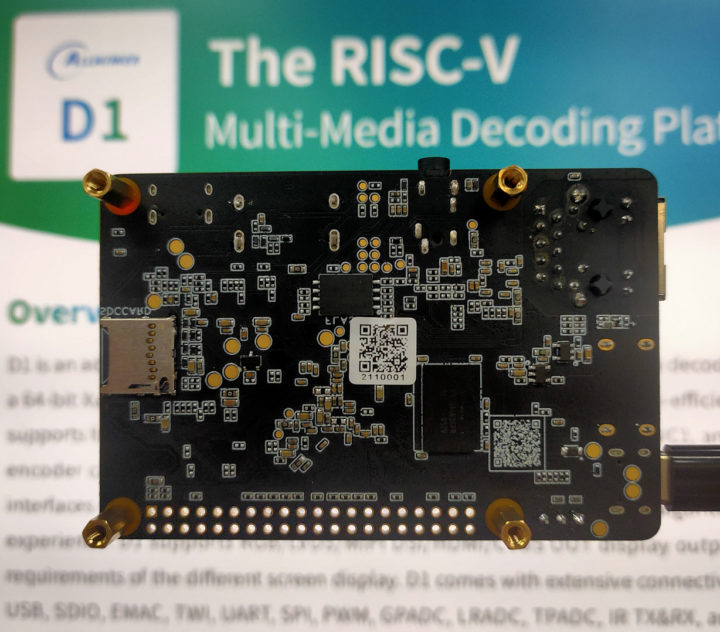Last year, we reported that Allwinner was working on an Alibaba XuanTie C906 based RISC-V processor that would be found in low-cost Linux capable single board computers selling for as low as $12.
The good news is that we won’t have to wait much longer as Allwinner D1 RISC-V processor is slated for an announcement next week, and a business card-sized SBC, also made by Allwinner, will become available in May. Some of the information is already available to developers in China, and CNX Software managed to obtain information about the Linux RISC-V SBC and Allwinner D1 processor.
Allwinner D1 development board
Let’s check out the board first which comes with the following specifications:
- SoC – Allwinner D1 single-core XuanTie C906 64-bit RISC-V processor @ 1.0 GHz with HiFi4 DSP, G2D 2D graphics accelerators
- Memory – 1GB DDR3 memory
- Storage – 256MB SPI NAND flash, MicroSD card slot
- Video
- Output – HDMI 1.4 port up to 4Kp30, MIPI DSI & touch panel interface up to 1080p60
- Decoding – H.265 up to 1080p60 or 4Kp30, H.264 up to 1080p60 or 4Kp24, MPEG-1/2/4, JPEG, VC1 up to 1080p60
- Encoding – JPEG/MJPEG up to 1080p60
- Audio – 3.5mm audio jack, digital audio output via HDMI, a connector for microphone board
- Connectivity – Gigabit Ethernet via RTL8211F PHY, 2.4GHz WiFi 4 & Bluetooth module via XR829 module
- USB – 1x USB 2.0 host port, 1x USB Type-C OTG portport
- Expansion – 40-pin GPIO connector
- Debugging – 4-pin UART header, USB ADB debugging supported
- Misc – Power LED, tri-color user LED, OK & FEL buttons
- Power Supply – 5V/2A via one of the two USB-C ports
- Dimensions – 85 x 56 mm (6-layer PCB)
That’s a pretty interesting board for smart displays, IP cameras, smart speakers, and other applications that do not require fast I/Os nor 3D graphics accelerators.
Allwinner should provide support for Debian-based Tina OS distribution, but usually, it’s using an ancient Linux kernel, so companies like Sipeed plan to send boards to developers, and I’ve also been told linux-sunxi community would get a board to get started with evaluation and development.

At this stage, it appears Allwinner does not offer the Allwinner D1 chips to third parties but sells them the board directly, possibly because of the lack of supplies. This may change in a few months.
Allwinner D1 RISC-V processor

We also have more details about the processor itself.
Allwinner D1 specifications:
- CPU – Alibaba XuanTie C906 64bit RISC-V core with 32 KB I-cache + 32 KB D-cache
- DSP – HiFi4 DSP 600MH with 32 KB I-cache + 32 KB D-cache, 64 KB I-ram + 64 KB D-ram
- Memory I/F – Up to 2GB DDR2/DDR3
- Storage I/F – SD3.0, eMMC 5.0, SPI Nor/Nand Flash
- Video Engine
- Video decoding
- H.265 up to 1080p@60fps, or 4K@30fps
- H.264 up to 1080p@60fps, or 4K@24fps
- MPEG-1/2/4, JPEG, VC1 up to 1080p@60fps
- Video encoding – JPEG/MJPEG up to 1080p@60fps
- Supports input picture scaler up/down
- Video decoding
- Video OUT
- RGB LCD output interface up to 1920 x 1080@60fps
- Dual link LVDS interface up to 1920 x 1080@60fps
- 4-lane MIPI DSI interface up to 1920 x 1080@60fps
- HDMI V1.4 output interface up to 4K@30fps
- CVBS OUT interface, supporting NTSC and PAL format
- Video IN
- 8-bit parallel CSI interface
- CVBS IN interface, supporting NTSC and PAL format
- Audio
- 2x DAC’s and 3x ADC’s
- Analog audio interfaces – MICIN1P/N, MICIN2P/N, MICIN3P/N, FMINL/R, LINEINL/R, LINEOUTLP/N, LINEOUTRP/N, HPOUTL/R
- Digital audio interfaces – I2S/PCM, DMIC, OWA IN/OUT
- Networking – 10/100/1000M EMAC with RMII and RGMII interfaces
- USB – USB2.0 OTG, USB2.0 Host
- Other peripherals
- SDIO 3.0, SPI x 2, UART x 6, TWI x 4
- PWM (8-ch), GPADC (2-ch), LRADC (1-ch), TPADC (4-ch), IR TX&RX
- Package – LFBGA BGA13*13/0.35/0.65mm,337 PINS
- Manufacturing process – 22nm
Right, but what about the logo?
You might say “Right, CNXSoft, the information about the processor and SBC is cool and all that, but what I really want to know is what about the logo on Allwinner D1 board?”
The good news is that I’ve got an answer for that too!
 It comes from (Nezha) which, as explained by Fandom, is:
It comes from (Nezha) which, as explained by Fandom, is:
the main protagonist in Investiture of the Gods and one of the supporting characters in the 16th-century Chinese classic novel Journey to the West by the late Wu Cheng’en, and its multiple adaptations. He is a protection deity and the son of Li Jing and Lady Yin.
There were also movie adaptations, including a recent 2019 animated film whose character is shown in the photo above.
Anyway, we may learn more next week with an official announcement and some information about pricing as well. This promises to be an interesting year for affordable Linux RISC-V SBC’s as the BeagleV development board is also slated to become available very soon.

Jean-Luc started CNX Software in 2010 as a part-time endeavor, before quitting his job as a software engineering manager, and starting to write daily news, and reviews full time later in 2011.
Support CNX Software! Donate via cryptocurrencies, become a Patron on Patreon, or purchase goods on Amazon or Aliexpress. We also use affiliate links in articles to earn commissions if you make a purchase after clicking on those links.






Let’s hope Allwinner gives proper official support on this SoC. I’m kind of hyped about this one.
I wouldn’t hold my breath… they don’t have a good track record… but we could be pleasantly surprised.
Indeed, little risk to be disappointed anyway, it remains Allloser 🙂 The only risk it to be pleasantly surprised.
You mean support for a mainline Linux? Allwinner does not have a good track record on that front…
“GPADC (2-ch), LRADC (1-ch), TPADC (4-ch)”
general purpose adc
low res adc
tp?
Touch Panel ADC, maybe?
Thermal ADC ?
data from a 2013 mp5 decoder device, probably it’s a touch panel adc (that can be converted to general adc purposes, at least on f1c100 SoCs
https://www.mikrocontroller.net/attachment/268937/F1E200_Datsheet_V1.pdf , page 31)
Yes, thx.
( https://github.com/torvalds/linux/blob/master/drivers/input/keyboard/sun4i-lradc-keys.c usage in kernel for a LRADC; previously there was GPADC used for touch panels instead of a ‘probably’ now specific TPADC, with most resources (4-channel) for that? Astonishing )
Allwinner is supported by sunxi community, that is one big point for their company, even they have not been very friendly or supportive to their community’s engagement?
Memory is on transition between DDR2 to DDR3, but that’s on open resources RISC-V cpu (for the ones care for that?)
>2.4GHz WiFi 4 & Bluetooth module via XR829 module
There goes ever having this thing working properly in mainline.
Why do they keep doing that? They know it’s useless in mainline since the zero came out. At some point, we need to admit that we’re in an abusive relationship with Allwinner.
I think the only way this situation will change is if Google starts using their parts in chromebooks and dictates that AW can’t ship the same 4.x kernel anymore. I don’t think the SBC market is really ships enough volume of a specific part for them to make the effort.
MediaTek have started trying to mainline everything and anything recently (Even the irq chip driver for the MSC313E..). Presumably because it’s either mainline or not ship a ton of chromebooks with their parts in them.
MediaTek chromebook user here.
Allwinner’s latest offerings appear to be trash. I’m not sure why any manufacturer would use them when there is MediaTek and Rockchip.
Probably the cost and nothing else. Their CPus are totally outdated by todays standards but are likely very cheap. Their customers don’t care about performance (it was already pretty low at the Cubietruck era). So it even makes sense to switch to a single-code RISCV at low frequency if that allows to further cut costs by removing some potential performance that is not sought.
They make really cheap cores for embedded market that fit perfectly with retrogaming console market (R8 for example) and that have all mainlined stuff now (thanks to linux sunix community, even not total, but no so bad Mesa driver support, that is enough to play with some 3d retrogaming stuff on a little screen.
Mediatek have work in progress with Nvidia for Chromebook. Might be why the are so suddenly interested in Linux support.
Nice DSP for the price especially considering the package as a whole. Industrial temperature range?
This is chip is optimized to build Amazon Echo type audio devices. There is a version of Alexa hot word detection that runs on that DSP. You can’t exactly clone the Echo Show with it because it is missing the h264 encoder for the camera. I suspect you can build similar devices more inexpensively using the ESP32-C3. And you’ll have fewer software issues.
Can you recommend any hot word detection framework to use with HiFi4, especially for R329?
The Knowles product line is based on HiFi4. This is a neat microphone chip with the Hifi4 inside of it. https://www.knowles.com/products/smart-mics
They also offer 2-8 mic far field all based on Hifi4
The R329 should be capable of running the Amazon software based hot word engine without needing an external chip. You have to get an Alexa business account opened (not just online developer account) and then your human account manager will give you access to it. It is a fair pain to get access to this and they may make you spend $50K on a third party consultant who will ensure that you use it properly.
The free Snowboy demo binary from Kitt.ai will also work. But it missing all of the audio front end. So you have to pay for a commercial license and then come up with the audio front end (Beamforming, AGC, AEC, etc).
A much simpler solution is to just use the ESP-C3 which is going to have Alexa support standard. It is in beta right now. The ESP-C3 can support the audio output too.
I’m trying to implement an hot word detection + speech recognition, maybe a stack like Snowboy+Vosk. It’d be really neat if I could offload the CPU-intensive part to the DSP and the NPU.
I will ask if I can get an Amazon business account but if it’s that hard, I better find some alternatives. Thanks a lot for the tips.
Hasn’t anyone figured out how to get that AIPU in the R329 to do hot word detection yet? Is that a HiFi4 with the name changed?
There are multiple implementations of hot word support on the Hifi4, but nothing that is open source. Allwinner is going to have to pay someone for their code or write it themselves.
You even have to pay to get access to the SDK for writing HiFi4 code.
There’s an SDK for AIPU of R329 in Allwinner’s official document site but I could not find anything about the DSP.
By the way there’re some official demos for TensorFlow, PyTorch, and ONNX for the AIPU and I’m working on them right now. If I can make something useful out of them, I will write about these on sunxi wiki.
Here is tensorflow implementation of hot word detection.
https://github.com/nyumaya/nyumaya_audio_recognition
The beamforming, AEC, AGC, etc code is in here:
https://freedesktop.org/software/pulseaudio/webrtc-audio-processing/
So you can run it on the host CPU until you can figure out how to get it running on the HiFi4. Note that Knowles does the AFE and the hotword both on the HiFi4.
First problem is getting access to the HiFi4 SDK. One indirect way to do that would be to start an evaluation of the Knowles chips and then get access to their SDK for customizing. The HiFi4 SDK is included in their SDK, but I don’t know if it has been altered. Knowles has changed the instruction set of their HiFi4 DSP implementation to add Knowles specific instructions.
where you able to get your hands on a R329 board by any chance ?
I am working with the Rockchip RV1109 currently.
I am looking for allwinner to mainline all drivers for this board 🙂
I am looking for me lucky charms.
Most of the drivers are already mainlined from ARM version of their SoCs. It looks like they just replaced ARM core CPU by RISC-V core CPU, and removed ARM GPU, that is probably a good move.
And there is now a working exemple of Mesa Radeon HD (made for x86) working on RISC-V, with few efforts, on Haiku:
https://discuss.haiku-os.org/t/my-progress-on-real-risc-v-hardware/10963/30
Offtopic, But that is not going well. Nvidia buying ARM, (like Oracle buying SUN).
RISC-V _is_ and _will be_ so much more fragmented than ARM 🙁
About this SBC I like the 2 USB Type-C, I’m fan of it. Can also replace HDMI and ETH with it. 🙂
Any word on a successor to the Kendryte K210?
The Allwinner V831, then the Rockchip RV1109/26.
Thanks Jon, but I was thinking more along the lines of a follow-up product in the Kendryte line.
I knew you were, AFAIK there isn’t one.
There were some talks about a Kendryte K510 last year, but nothing concrete has surfaced since then.
I wonder when (open) RISC-V GPUs will appear… It seems that they’re a large missing piece of the SBC puzzle.
They should appear shortly after we eliminate the patent system.
There are already several projects, including GPGPU and just GPU opensource and closed, just hope one will be available on this kind of board. There is an European Union computing accelerator based on RISC-V currently in pre-production test in Barcelona for a new European supercomputer architecture, the project started few years ago. It is based on ARM CPU and then RISC-V accelerator, and I seen Nasa want to make one too.
Like this I was reading earlier this year
” A group of enthusiasts are proposing a new set of graphics instructions designed for 3D graphics and media processing. These new instructions are built on the RISC-V base vector instruction set. They will add support for new data types that are graphics specific as layered extensions in the spirit of the core RISC-V instruction set architecture (ISA). Vectors, transcendental math, pixel, and textures and Z/Frame buffer operations are supported. It can be a fused CPU-GPU ISA. The group is calling it the RV64X as instructions will be 64-bit long (32 bits will not be enough to support a robust ISA).
“
I hope they do an embedded version like the Pi’s Compute Module.
Like that one?
https://www.cnx-software.com/wp-content/uploads/2020/11/Allwinner-RISC-V-SoM-768×513.jpg
It was shared by Sipeed last year. So they are working on it, but if Allwinner is not selling the processor right now, it may take several more months.
If you have an application that can run on a single (relatively) slow core why not use one of the many Cortex A7s with memory integrated.. Allwinner already sells a bunch of those.
The 2 layer PCB you need will end up cheaper than just the connectors for a pi like module,
Yeah, but it’s not RISC-V.
Does that matter?
So … what will be the price of this RISC-V SBC? With the BoM (1GB RAM etc), I cannot imagine it will be the $12 that was mentioned.
Oh, wait: the Raspberry Pi Zero W (with 0,5GB RAM) is 11,50 Euro incl VAT retail … so maybe the 12 USD is feasible …
The $12 is for another one which we haven’t seen yet. It should be smaller and with just 32/64MB RAM. This board may cost up to $50, hopefully less.
Finally I’ve got price information, and it’s quite higher than expected
That’s the MSRP, and the actual price may be a little lower.
100 USD for a single-core SBC, with unclear Linux and open source support … that’s quite a price …
The boards will be cheaper later. The first one is always expensive. The first board for the V831 was $500. Now they are $10.
Could be point us in the direction of one such $10 board? Thanks!
Example of $10 RISC-V Linux board
https://www.cnx-software.com/2021/10/30/open-source-hardware-allwinner-d1s-risc-v-linux-sbc/
That one is DIY, but more are coming.
let’s see if that chip becomes popular enough so that other SBCs appear.
btw any SBC for R329 yet ? 😛
I have to correct you:”Debian-based Tina OS distribution” is wrong! Tina is OpenWRT-based
mmmh great to see allwinner is moving to RISC-V, but I still prefer the R329, dual A53 @ 1.5GHz with integrated DDR and also Hifi4 DSP. If I can avoid external DDR in my design, it’s a huge plus.
D1 Nezha board is being promoted on Official Allwinner Taobao store banners for ¥299, alongside R329 but it’s not actually possible to purchase it yet.
https://shop411926351.taobao.com/
Unless I read that wrong (and that’s not impossible), I see the processor is 295 RMB, the board 399 RMB.
Oh sorry, you’re right. My mistake. Board is 399 RMB and judging from R329 SoC price tag, 5 pieces of D1 SoC is probably 295 RMB.
https://item.taobao.com/item.htm?id=645082459931
now it’s more than 2 months, where is the board to buy?
On Aliexpress where else
https://fave.co/3yIv24n